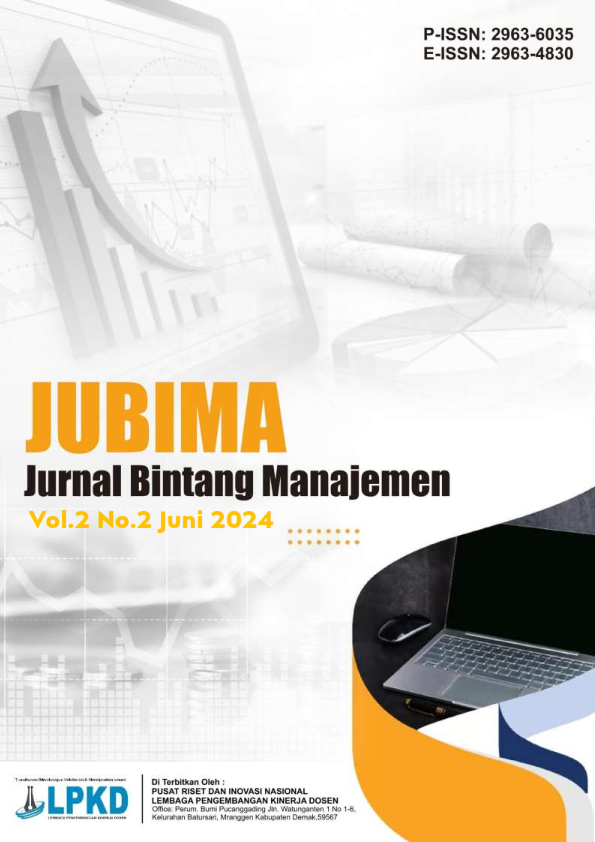Pentingnya Perencanaan Sumber Daya Manusia Dalam Sebuah Organisasi
DOI:
https://doi.org/10.55606/jubima.v2i2.3135Keywords:
Human Resources Planning, OrganizationAbstract
Human resource planning is the first thing an organization or company must do when the company seeks better human resource management. All organizations or companies must determine their future with various different plans following current developments. Currently, changes are occurring quite rapidly, so organizations or companies must be able to keep up with the changes that are occurring quickly and precisely. Organizations or companies must be able to anticipate and adapt to change. Therefore, personnel planning is becoming increasingly important for companies, because the era of globalization, new technologies and organizational change processes overshadow organizational life repeatedly. An organization that is not supported by employees with good quantity, quality, strategy and function, of course the organization will find it difficult to maintain and develop its existence in the future, so that personal planning is successful. Human resource (HR) planning plays a crucial role in organizational success by ensuring the continuity of efficient and effective operations. In the context of globalization and rapid change, HR planning is becoming increasingly important to identify the need for quality and visionary human resources. The unique characteristics of an organization are also a focus in this abstract, where a unique business strategy can become a competitive advantage that is difficult for competitors to imitate. Evaluation of employee performance based on industry principles and the influence of organizational politics as well as a poor evaluation system on employees are also highlighted in this abstract. By understanding the critical challenges facing organizations, including in the context of globalization, HR planning can help organizations to strengthen their position in global competition and face change more adaptively.
References
Aristanto, A., Supriatna, E., Panggabean, H. M., Apriyanti, E., Hartini, H., Sari, N. I., & Kurniawati, W. (2023). The Role of Artificial Intelligence (AI) at School Learning. Consilium: Education and Counseling Journal, 3(2), 64–71. https://doi.org/10.36841/consilium.v3i2.3437
Budi W Sutjipto, 2002. Paradigma Baru Manajeman Sumber Daya Manusia, Amara Book, Yogyakarta
Bungaran, D., & Hartini. (2023). Pengaruh Stres Kerja dan Motivasi terhadap Kinerja Pegawai di KPUBC Tipe A Tanjung Priok. https://www.researchgate.net/publication/373018377
Chanderjeet. (2018). Human Resource Planning Importances for Organization. International Journal of Creative Research Thoughts (IJCRT), 6(1), 183-186. ISSN: 2320-2882.
Dhani Habibi, & Hartini. (2023). Balanced Scorecard-Based Performance Management at KPPBC TMP Merak. https://www.researchgate.net/publication/372992250
Hadari Nawawi, 1997. Manajemen Sumber Daya Manusia Untuk Bisnis yang Kompetitif, Gadjah Mada University Press, Yogyakarta
Henry Simamora, 1997. Manajemen Sumber Daya Manusia, Edisi Kedua, STIE YKPN,Yogyakarta.
Jackson Schuler, 1990. Human Resource Planning: Challenges for Industrials/Organization Psycologist, New York
Martoyo.Susilo, Manajemen Sumberdaya Manusia, edisi 4,2000, BPFE, Yogyakarta
Rhenal Kasali, 2005. Change, Gramedia, Jakarta
Rivai Veitzal, 2004, Manajemen Sumberdaya Manusia untuk perusahaan, dari teori ke praktek, PT. Raja GrafindoPersada, Jakarta
Safarudin Alwi, 2001. Manajemen Sumber Daya Manusia, BPFE UGM, Yogyakarta.
Sulistiyani, A. T., & Rosidah. (2003). Manajemen Sumber Daya Manusia. Yogyakarta: Graha Ilmu.








